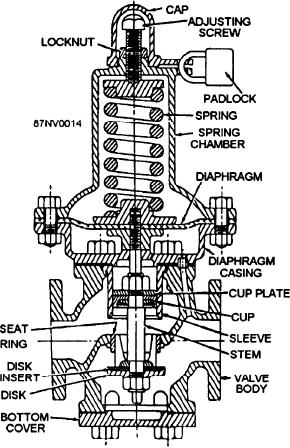valve looks very much like a lift-check valve.
However, the valve stem is long enough so that when it
is screwed all the way down it holds the disk firmly
against the seat, thereby preventing the flow of any
fluid. In this position, the valve acts as a stop valve.
When the stem is raised, the disk can then be opened by
pressure on the inlet side. In this position, the valve acts
as a check valve and allows the flow of fluid in one
direction only. The amount of fluid allowed to pass
through is regulated by the opening. The opening is
adjusted by the stem.
PRESSURE-REDUCING VALVES
Pressure-reducing valves are automatic valves that
are used to provide a steady pressure lower than that of
the supply pressure. Pressure-reducing valves can be
set for any desired discharge pressure that is within the
limits of the design.
There are several types of reducing valves in the
Navy. However, you will be working mostly with those
in the flushing system. These will normally be
single-seated, direct-acting, and spring-loaded, as
shown in figure 15-14. Water passing through this
Figure 15-14.--Spring-loaded, diaphragm-type
valve is controlled by means of a pressure difference on
pressure-reducing valve.
both sides of the diaphragm. The diaphragm is secured
to the stem. Reduced water pressure from the valve
outlet is then led through an internal passage to a
The amount of pressure applied by the spring to the
diaphragm chamber that is located below the
top of the diaphragm can be adjusted by turning an
diaphragm. An adjusting spring acts on the upper side
adjusting screw. Turning the adjusting screw clockwise
of the diaphragm. A leather cup washer or a neoprene
will increase the pressure applied by the spring to the
O-ring makes the water seal between the valve inlet and
top of the diaphragm, which in turn opens the valve.
the diaphragm chamber. This seal is located halfway
Turning the adjusting screw counterclockwise will
down the valve stem.
decrease the amount of spring pressure on top of the
The amount of water pressure applied to the
diaphragm, which in turn decreases the amount of
underside of the diaphragm varies according to the
discharge.
discharge pressure. When the discharge pressure is
The opening and closing of the valve will continue
greater than the spring pressure, the diaphragm is forced
as long as the discharge pressure fluctuates. For
up. Since this is an upward-seating valve, the upward
example, when a water closet is flushed, the pressure
movement of the stem tends to close the valve or at least
drops in the supply line. This line is on the discharge
to decrease the amount of discharge. When the
side of the pressure-reducing valve. Therefore, the
discharge pressure is less than that of the spring
diaphragm will move down and open the valve. As the
pressure, the diaphragm and the valve stem are forced
flushometer closes, the pressure builds up again and
down, opening the valve wider and increasing the
closes the reducing valve.
amount of discharge. When the discharge pressure is
equal to the spring pressure, the valve stem will remain
PNEUMATIC-PRESSURE-CONTROLLED
stationary and the flow of water through the valve is not
REDUCING VALVES
changed.
There
are
two
types
of
the
pneumatic-pressure-controlled (or gas-loaded)
reducing valve. One type regulates low-temperature
15-13






